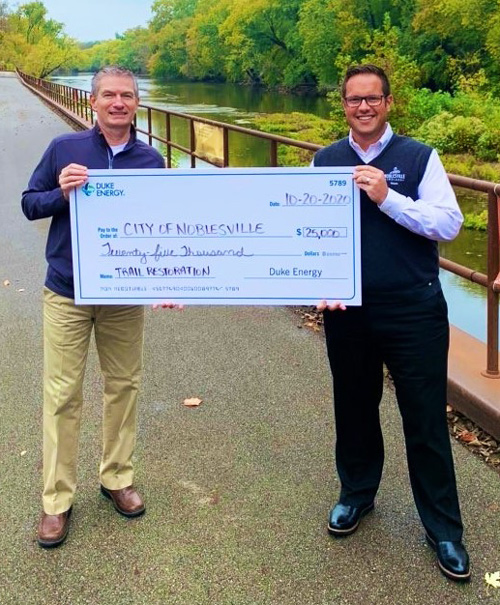The City of Noblesville recently received a $25,000 Powerful Communities Grant from Duke Energy for habitat and forest restoration and conservation along the White River.
“We are grateful for Duke Energy’s conservation efforts and funding to help preserve one of our city’s amenities and open it both visually and physically to more resident interaction,” Mayor Chris Jensen said.

Duke Energy Government & Community Relations Manager Mark LaBarr (left) and Noblesville Mayor Chris Jensen. (Photo provided)
The year-long project, which begins in mid-October, targets the east bank of White River between Maple Street and Division Street for invasive species removal, native species planting, and habitat restoration over two events during the year.
“The White River Trail Riparian Restoration seeks to create accessible pedestrian approaches to White River in order to enable residents to interact with and appreciate the river,” Noblesville’s MS4 Coordinator Tim Stottlemyer said. The density of invasive overgrowth has literally become a barrier to residents’ access to long stretches of the riverbank.”
In addition to Duke Energy’s grant, the city’s project has received $26,630 of in-kind donations in man-hours, technical expertise, equipment, education and public outreach from the Boy Scouts of America, Hamilton County Soil & Water Conservation District, local Cooperative Invasive Species Management Area chapter and the White River Alliance.
“The template we create of sequential actions for returning an area to native growth will outline monitoring protocols for measuring effectiveness and serve as a guide for similar efforts on other city-owned land,” Stottlemyer said. “We are certain that year after year, more residents will discover that they can walk right down to the river without fighting through overgrowth to enjoy a long-under-realized amenity.”
The White River Trail Riparian Restoration goals include:
- Clear Asian Bush Honeysuckle and Garlic Mustard species from 850 feet of the east riverbank to an average depth of 75 feet from water’s edge, and enable new microclimates by planting Sycamore trees and other native species.
- Make the White River more visually accessible, and to make it physically accessible to individuals or groups wishing to interact with the river by clearing route impediments caused by overgrowth.
- Utilize created tools such as a written Management Plan and a Work Plan Template to enable easier replication along other stretches of riverbank, thereby increasing community support stemming from scheduled projects.
